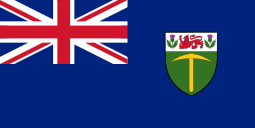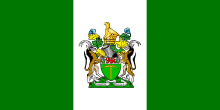Flag of Rhodesia


.svg.png)


The flag of Rhodesia (now Zimbabwe) changed many times as a result of political changes in the country.
Before 1953, the then Colony of Southern Rhodesia followed British colonial practice, by using a Blue Ensign with the Union Flag in the canton and the shield from the colony's coat of arms in the fly.
In 1953, Southern Rhodesia federated with Northern Rhodesia and Nyasaland to form the Federation of Rhodesia and Nyasaland. The federal flag was used between September 1953 and 31 December 1963 when the federation was dissolved. Less than a year after the break-up of the Federation, Northern Rhodesia and Nyasaland became the independent states of Zambia and Malawi respectively. Southern Rhodesia became known simply as Rhodesia, although its legal name remained the Colony of Southern Rhodesia. In April 1964 Rhodesia adopted a light air force ensign with the shield from the coat of arms of Rhodesia in the fly. This was the first time the lighter shade of blue ensign was used by a British colony, although Fiji and Tuvalu both adopted the colour after independence.
Following the Unilateral Declaration of Independence (UDI) on 11 November 1965, the flag was retained, but three years later on the anniversary of UDI it was replaced by a green and white flag (similar to that of Nigeria) with the full coat of arms in the centre. On 2 March 1970, the country was declared a republic. Throughout this time, Britain refused to recognise Rhodesia's independence and maintained that the light-blue ensign was the official flag of the country.
In 1979, the country became known as Zimbabwe-Rhodesia and a new flag was adopted on 2 September that year featuring the pan-African colours of red, black, yellow and green, and the Zimbabwe Bird. However, under the terms of the Lancaster House Agreement, the country briefly returned to British rule under the Union Jack from 12 December 1979 although the Zimbabwe Rhodesia flag remained de facto in use. Thus it was the British Union Flag that was lowered during the ceremony on 17/18 April 1980 marking the country's attainment of independence as the Republic of Zimbabwe when the new flag of Zimbabwe was adopted.
Official description
The following was published as a supplement to the Government Gazette issued on Friday 9 August 1968.
1968 Flag of Rhodesia No. 40 / p. 285
Rhodesia Act
To provide for the adoption of a national flag for Rhodesia; to provide for the making of regulations to restrict or control the application to any goods of a reproduction of such flag; to amend section 16 of the Merchandise Marks Act, 1957, and to provide for matters incidental to the foregoing.
BE IT ENACTED by His Excellency the Officer Administering Government as representative of the Queen's Most Excellent Majesty, by and with the advice and consent of the Parliament of Rhodesia, as follows: -
1. This Act may be cited as the Flag of Rhodesia Act, 1968.
2. The Flag of Rhodesia shall be a flag consisting of three vertical stripes of equal width, green, white and green, on which there appears in the centre of the white stripe the coat of arms of Rhodesia, with -
(a) the length of the flag equal to twice the width of the flag; and
(b) the coat of arms of Rhodesia equal in height to three-fifths of the heights of the flag.
3. The Minister of Justice shall cause a copy of the Flag of Rhodesia to be prepared and deposited in the National Archives of Rhodesia established in terms of the National Archives Act, 1963 (No. 76 of 1963).
4. (1) Where, in the opinion of the Officer Administering the Government, it is necessary to regulate and control the use of the Flag of Rhodesia in order that it is not used for purposes which, in his opinion, are improper he may make such regulations restricting, regulating or controlling the application to any goods or the importation into Rhodesia of any goods to which there has been applied a reproduction of the Flag of Rhodesia or of a flag which resembles or is intended to resemble the Flag of Rhodesia as he may consider to be necessary or expedient for the purpose.
(2) Regulations made in terms of subsection (1) may provide for penalties for any contravention thereof, including provision for the forfeiture of any goods to which a reproduction of the Flag of Rhodesia or of a flag which resembles or is intended to resemble the Flag of Rhodesia has been applied or which have been imported in contravention of such regulations:
Provided that no such penalty shall exceed a fine of five hundred pounds or imprisonment for period of two years, excluding the value of any goods forfeited.
5. Any person who burns, mutilates or otherwise insults the Flag of Rhodesia or a flag which resembles or is intended to resemble the Flag of Rhodesia or any reproduction thereof in circumstances which are calculated or likely to show disrespect for the Flag of Rhodesia or to bring the Flag of Rhodesia into disrepute shall be guilty of an offence and liable to a fine not exceeding five hundred pounds or to imprisonment for a period not exceeding two years.
6. Section 16 of the Merchandise Marks Act, 1957 is amended, in subsection (1), by repeal of subparagraph (iii) of paragraph (b).
[[Coloured sheet]][1]
Flag of the Governor of Southern Rhodesia

The flag used by the Governor of Southern Rhodesia followed the usual pattern for representatives of the British Crown. It consisted of a defaced Union Flag (Union Jack) with a white disc in the center of the flag. Within the center of the disc was the shield from the Southern Rhodesian Coat of Arms. This flag was not used during the Unilateral Declaration of Independence (UDI) years and became obsolete when the post of Governor disappeared after the independent Republic of Zimbabwe came into being in 1980.
In most of the British colonies the flags used by the Sovereign's representative usually followed the same general design. In Southern Rhodesia, the Governor was appointed by the Crown and acted as the local head of state, receiving instructions from the British Government. The Governor was also Commander-in-Chief of the armed forces and as such, in theory at least, exercised considerable influence over the running of the colony and its government. In practice, however, the Governor's main function was to maintain a satisfactory relationship between the British and Southern Rhodesian Governments and acted in an advisory capacity most of the time.
In Southern Rhodesia, the Governor initially flew a Union Flag with a white roundel in the centre charged with the shield from the colony's arms granted on 11 August 1924. Unique among the flags of the Governors of British Colonies, this shield of Arms was not surrounded by the customary wreath. Southern Rhodesia became a British Colony on 12 September 1923. This flag was put into use on 1 October 1924 and was flown until 30 July 1951.
On 31 July 1951, a new flag was put into use for the Governor of Southern Rhodesia. This was dark blue and charged in the centre with a Royal Crown, its height being four-sevenths of the hoist. Initially the Tudor Crown would have been used, but after her accession to the throne in 1952, Queen Elizabeth II indicated her preference for St Edward's Crown and this version would have been used thereafter. Like its predecessor, this flag did not conform to the usual pattern of the flags used by British Colonial Governors which was to have dark blue flag charged in the centre with the Royal Crest above a Crown, with the name of the Colony or Dominion written in a yellow scroll below. The reason for Southern Rhodesia not conforming to this pattern is probably explained by the unique Constitutional Status of the colony, having attained 'Responsible Government' in 1923, but not being a fully fledged Dominion.
Gallery
-
.svg.png)
Flag of the Governor of Southern Rhodesia (1951–1970)
-

Personal Flag of the Governor of Southern Rhodesia
-

Flag of the President of Rhodesia (1970–1980)
-

Flag of the Prime Minister of Rhodesia (1970–1979)
-

Car flag of the Prime Minister of Zimbabwe Rhodesia (1979–1980)
-
.svg.png)
Royal Rhodesia Air Force Ensign (1953–1963)
-
.svg.png)
Royal Rhodesia Air Force Ensign (1964–1968)
-
.svg.png)
Rhodesian Air Force Ensign (1970–1979)
-

Zimbabwe Rhodesia Air Force Ensign (1979–1980)
References
- ↑ http://www.fotw.net/Flags/zw-rhod.html Flags of the World